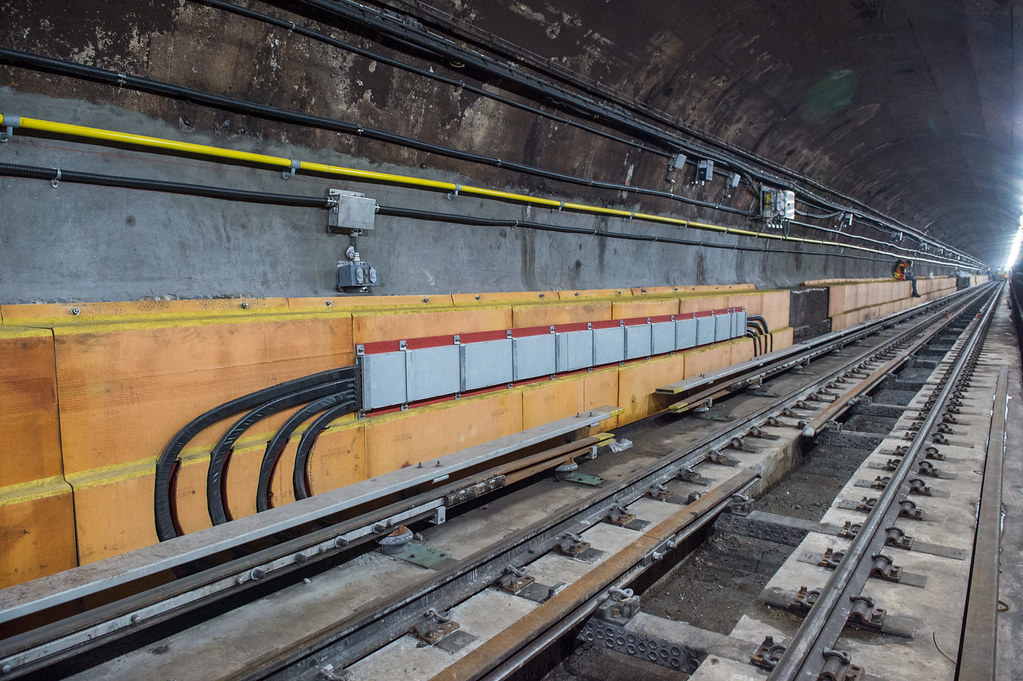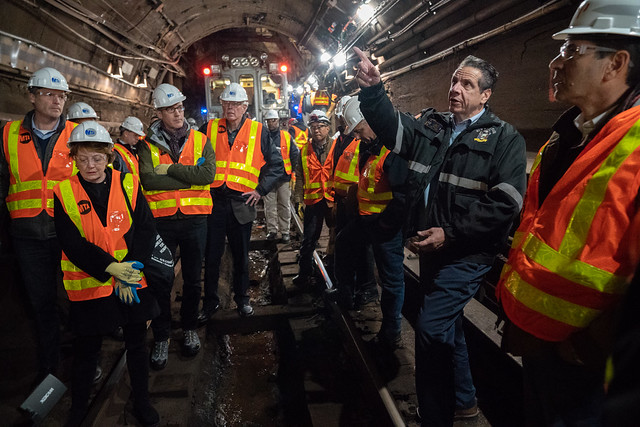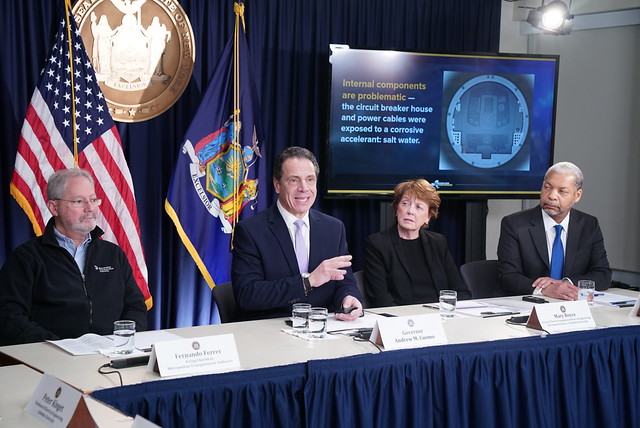
A glimpse inside the completed L train tunnel. Fiber-reinforced polymers protect the benchwall destroyed by Sandy’s floodwaters. (Photo: Trent Reeves/MTA Construction & Development)
Gov. Andrew Cuomo interrupted the steady drumbeat of bad and depressing news during his daily COVID-19 press conference on Sunday to share what many knew was coming: The MTA’s rehabilitation work on the L train has been completed. Of course, as with many Cuomo-driven MTA projects, completed doesn’t really mean completed, as a whole bunch of finishes and other behind-the-scenes work will trickle to completion throughout the summer, but the work requiring service changes is finished, three months ahead of the schedule developed last year and without a full-time shutdown.
The governor, as is his wont, took a victory lap. “While New Yorkers continue to cope with the devastating impact of COVID-19, the L train project completion is timely proof that when we are confronted with a challenge we can build back better and stronger – especially when we work together and think outside the box,” Governor Cuomo said. “Everyone said we had to shut down the tunnel for 15 to 18 months, which was going to be a massive disruption for thousands of New Yorkers who rely on the L train. We challenged those who said there was no alternative solution and as a result today the MTA is delivering a more resilient tunnel with improved service that is ahead of schedule and under budget – all while averting a shutdown.”
Ultimately, according to Cuomo, the MTA saved around $100 million on the L train project from the initial $926 million budgeted for the full shutdown. The MTA however has never released a full accounting so it’s not clear how those savings came about or whether a project of this scope would have cost less if initially planned this way. Still, the L train shutdown work is an MTA success story albeit with a few caveats I’ll get to shortly. The MTA, at the direction and control of the governor, successfully executed on a new-to-them approach to reconstructing and re-wiring a tunnel. There were a few hiccups along the way as delayed work train movement torpedoed a few rush hour commutes, but the technical aspects of the work, meticulously documented in the L Project weekly newsletter largely went off as planned. The MTA was forced to think out of the box, and they did.
The laundry list of new technologies is one we all grew intimately familiar with in early 2019 — fiber-reinforced polymer to protect the damaged benchwall, cable racks, fiber optic monitoring systems — and included some new ones along the way such as a third rail repurposed into a fourth rail for negative power returns. And the remaining work is hardly of the nature of the Second Ave. Subway when the fire monitoring systems weren’t ready for opening day. The agency has to finish the elevators in Manhattan and some new entrances and the fan plant on the Brooklyn side of the Canarsie Tunnel. All told, this remaining work should wrap by the fall.

Cable racks, rather than a benchwall reconstruction, helped avoid a full-time shutdown of the Canarsie Tunnel. (Photo: Trent Reeves/MTA Construction & Development)
But in addition to the loose ends inside the tunnels, the same questions transit watchers had in early 2019 as the shutdown morphed into the not-a-shutdown loom, and it’s worth thinking about them again as the project recedes into the past. They’re all a part of the twisted legacy of the L train work whether the Governor wishes to acknowledge them or not.
How long will this work last?
This is of course the question that has hovered over the L train work since The Times published Carmen Bianco’s op-ed. The MTA anticipated that a full benchwall rebuild would last another 100 years while experts claimed the MTA’s new approach would have a life cycle of around 40 years. Plus, if the fiber reinforced polymers fail, the agency will have to clear out the tunnel. Right now, we just don’t know how long this work will last, and anyone in charge today will be long gone when we find out.
Andy Byford and the safety assessment
When Cuomo first stepped in, the L train project was under the purview of Andy Byford and New York City Transit, and the last-minute change in scope and approach was the spark that lit the kindling. The former NYCT President wanted to hire an independent company to conduct a safety assessment to validate the untested plan put forward by Cuomo and his team of engineers. Cuomo did not want to do that, and so the MTA moved the L train work from under Byford’s control to Janno Lieber’s at MTA Capital Construction. The safety assessment — proposed to ensure that the new approach would be safe for workers and riders — never materialized, and the relationship between Cuomo and Byford deteriorated from there. Ultimately, Byford was right to request the safety assessment, and we’re worse off without both that report and Andy Byford.
What future the 14th St. Busway?
Along with the L train shutdown came the 14th St. busway. Slowed, of course, by the protestations of West Village NIMBYs, the bus was an immediate success story during its first few months of service. But along with the pandemic came a huge slowdown in both transit usage and traffic in Manhattan, and the future of the 14th St. busway pilot is in doubt. Sam Schwartz Engineering was supposed to release regular updates, but the team’s winter quarterly report hasn’t been made public yet. It seems likely that the spring report won’t have meaningful data, and the remaining 11 months of the pilot are clouded by the unknown length of the impact of the coronovirus pandemic. Will the city and MTA commit to the 14th St. Busway? Can it still serve as a model for other busways throughout the city? It should, and I hope so. But a lot of the data necessary to bolster the argument will be at best incomplete for the foreseeable future.
The L train project re-think ultimately carried with it a high price, both in dollars and personnel. It drove a permanent wedge between the governor’s office and the man trusted by the public to fix the subways. It threw years of planning and city-state coordination into doubt. It deepened the MTA’s credibility crisis. But the work seems to have been a guarded success. When pushed, the MTA can execute creatively and efficiently. Now if only the agency would do this without such an aggravating and costly push.









